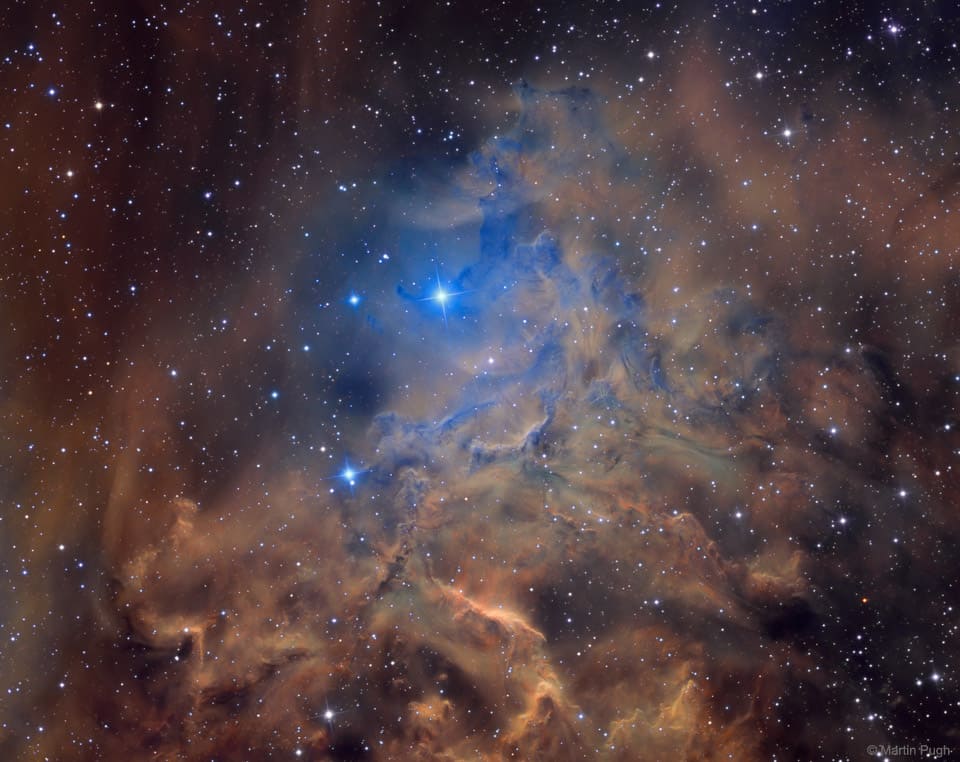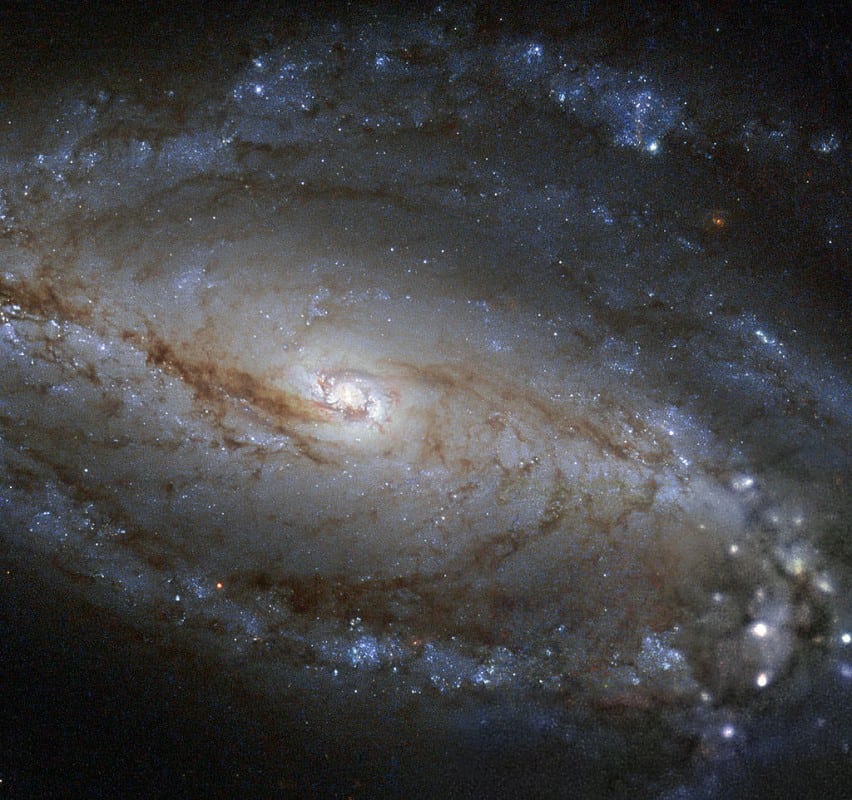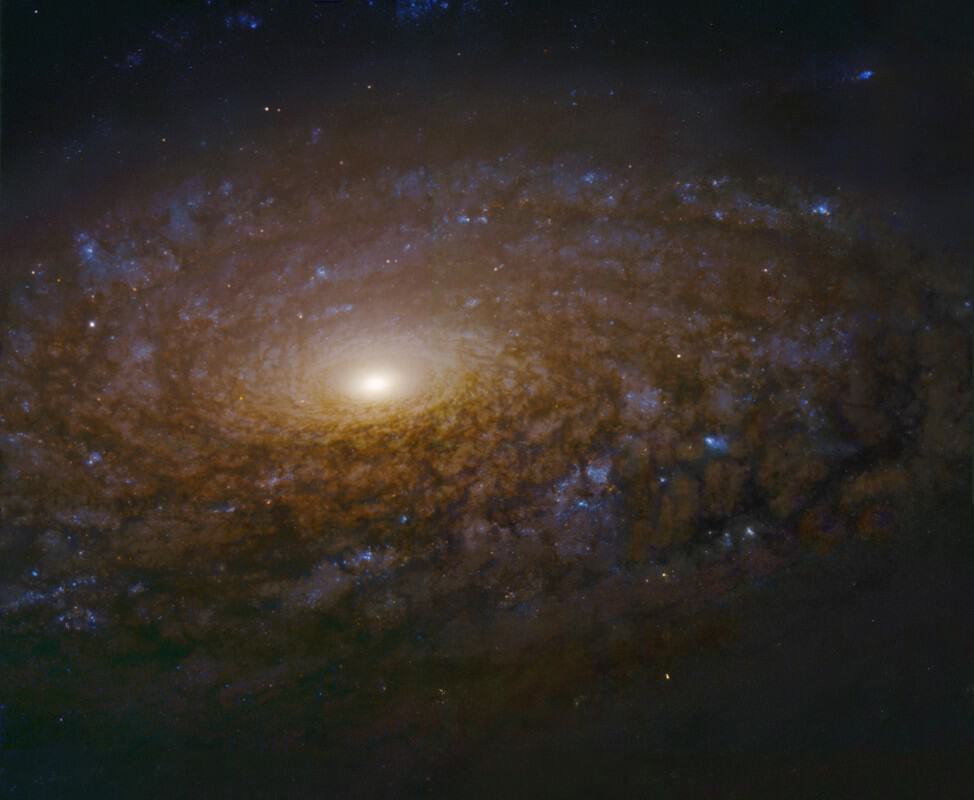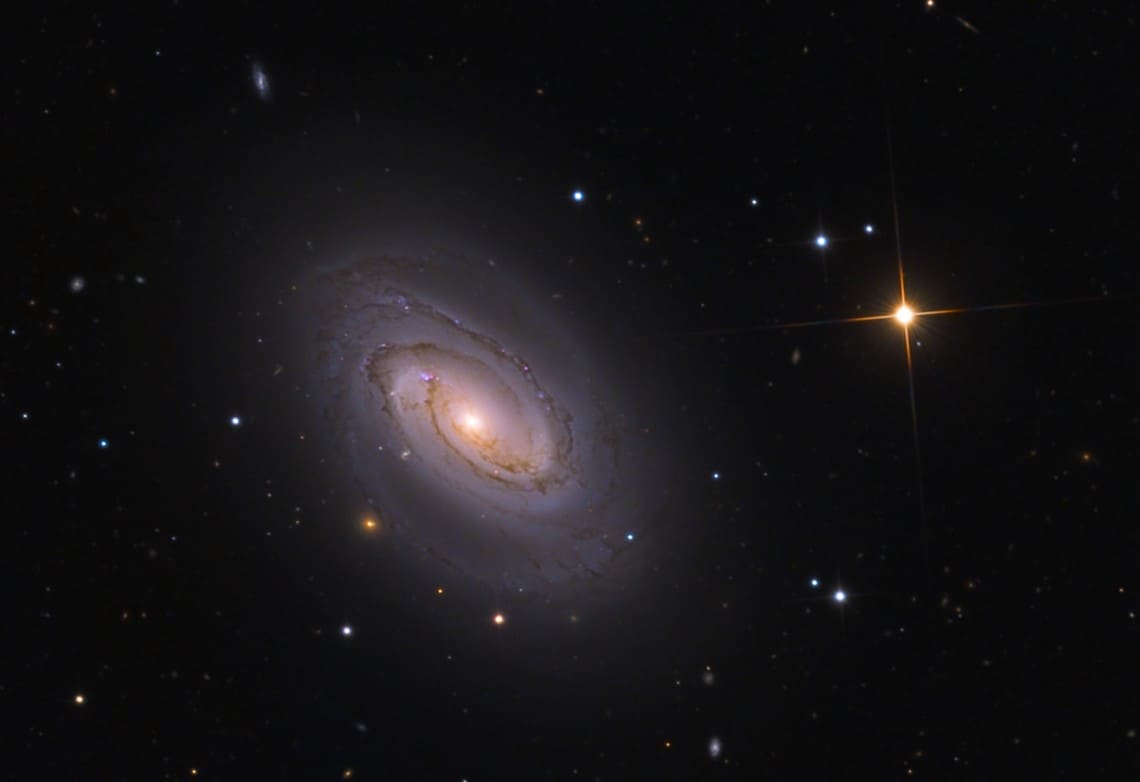Blog
NGC 613 is a barred spiral galaxy located some 67 million light years away in the southern constellation of Sculptor. It is a candidate outlying member of the Sculptor Group, a gravitationally-bound group of galaxies. This galaxy was discovered in 1798 by German-English astronomer William Herschel, then re-discovered and catalogued by Scottish astronomer James Dunlop. It was first photographed in 1912, which revealed the spiral form of the nebula. During the twentieth century, radio telescope observations showed that a linear feature in the nucleus was a relatively strong source of radio emission.
NGC 613 is inclined by an angle of 37° to the line of sight from the Earth along a position angle of 125°. The morphological classification of NGC 613 is SBbc(rs), indicating that it is a spiral galaxy with a bar across the nucleus (SB), a weak inner ring structure circling the bar (rs), and moderate to loosely wound spiral arms (bc). The bar is relatively broad but irregular in profile with a position angle that varies from 115–124° and dust lanes located along the leading edges. Star formation is occurring at the ends of the bar and extending along the well-defined spiral arms. The central bulge is readily apparent, with a radius of 14″.
The classification of the nucleus is of type HII, indicating a match to the spectrum of an H II region. Near the core, the stars have a velocity dispersion of 136 ± 20 km/s. The nucleus is a source of radio emission with the form of an inner ring with a radius of about 1,100 ly (350 pc) and a linear feature that is perhaps perpendicular to it. The latter consists of three discrete blobs spanning approximately 2,000 ly (600 pc).Observations suggest the presence of a supermassive black hole at the core with a mass in the range (1.9–9.6) × 107 times the mass of the Sun.
more...Lewis Brian Hopkin Jones (28 February 1942 – 3 July 1969) was an English musician, best known as founder and the original leader of the Rolling Stones. Initially a slide guitarist, Jones would go on to play a wide variety of instruments on Rolling Stones recordings and in concerts, such as rhythm and lead guitar, various keyboard instruments such as piano and organ, marimba, harmonica, sitar, wind instruments such as recorder, saxophone, oboe, and numerous others. Jones and fellow guitarist Keith Richards developed a unique style of guitar play that Richards refers to as the “ancient art of weaving” where both players would play both rhythm and lead parts together; Richards would carry the style on with later Stones guitarists and the sound would become a Rolling Stones trademark.
A few years after he founded the Rolling Stones as a British blues outfit in 1962, and gave the band its name, Jones’ fellow band members Mick Jagger and Keith Richards began to take over the band’s musical direction, especially after they became a successful songwriting team. Jones also did not get along with the band’s manager, Andrew Loog Oldham, who pushed the band into a musical direction at odds with Jones’s blues background. At the same time, Jones developed a drug problem, and his performance in the studio became increasingly unreliable, leading to a diminished role within the band he founded. The Rolling Stones asked Jones to leave in June 1969 and guitarist Mick Taylor took his place in the group. Jones died less than a month later by drowning in the swimming pool at his home while under the influence of drugs.
more...John Aloysius Fahey (February 28, 1939 – February 22, 2001 Washington DC) was an American fingerstyle guitarist and composer who played the steel-string acoustic guitar as a solo instrument. His style has been greatly influential and has been described as the foundation of American Primitive Guitar, a term borrowed from painting and referring mainly to the self-taught nature of the music and its minimalist style. Fahey borrowed from the folk and blues traditions in American roots music, having compiled many forgotten early recordings in these genres. He would later incorporate classical, Portuguese, Brazilian, and Indian music into his œuvre. He spent many of his later years in poverty and poor health, but enjoyed a minor career resurgence with a turn towards the more explicitly avant-garde, and created a series of abstract paintings during the last years of his life. He died in 2001 from complications from heart surgery. In 2003, he was ranked 35th in the Rolling Stone “The 100 Greatest Guitarists of All Time” list.
more...Willie Bobo was the stage name of William Correa (February 28, 1934 – September 15, 1983), a Latin and jazz percussionist of Puerto Ricanancestry.
William Correa grew up in Spanish Harlem, New York City. He made his name in Latin Jazz, specifically Afro-Cuban jazz, in the 1960s and 1970s, with the timbales becoming his favoured instrument. He met Mongo Santamaría shortly after his arrival in New York and studied with him while acting as his translator, and later at the age of 19 joined Tito Puente for four years.
The nickname Bobo is said to have been bestowed by the jazz pianist Mary Lou Williams in the early 1950s.
His first major exposure was when he joined George Shearing‘s band on the album The Shearing Spell. After leaving Shearing, Cal Tjader asked Bobo and Santamaría to become part of the Cal Tjader Modern Mambo Quintet, who released several albums as the mambo craze reached fever pitch in the late ’50s. Reuniting with his mentor Santamaría in 1960, the pair released the album Sabroso! for the Fantasy label. Bobo later formed his own group, releasing Do That Thing/Guajira with Tico and Bobo’s Beat and Let’s Go Bobo for Roulette, without achieving huge penetration.
https://www.youtube.com/watch?v=BLtLJD1rN_0
more...RHYTHM ROOTS WORKSHOP
Tuesday February 27th 2018 noon-2pm
Partnership Resources Inc. St Louis Park
Discovering the internal rhythmic components deep within our genetic coding demonstrated by the Developmentally Disabled community.
more...
NGC 3521 is a flocculent intermediate spiral galaxy located around 26 million light-years away from Earth in the constellation Leo. It has a morphological classification of SAB(rs)bc,which indicates that it is a spiral galaxy with a trace of a bar structure (SAB), a weak inner ring (rs), and moderate to loosely wound arm structure (bc). The bar structure is difficult to discern, both because it has a low ellipticity and the galaxy is at a high inclination of 72.7° to the line of sight. The relatively bright bulge is nearly 3/4 the size of the bar, which may indicate the former is quite massive.The nucleus of this galaxy is classified as an HII LINER, as there is an H II region at the core and the nucleus forms a low-ionization nuclear emission-line region.
more...Harold Jones (born February 27, 1940) is an American traditional pop and jazz drummer who is best known as the drummer for Tony Bennett and for his five years with the Count Basie Orchestra.
In a career spanning six decades, Jones has toured and recorded with Frank Sinatra, Duke Ellington, Oscar Peterson, Herbie Hancock, B.B. King, and Ray Charles. He has also played with major symphony orchestras, including those in Boston, Atlanta, Chicago, London, Los Angeles, San Francisco, and Vienna.
He attended the American Conservatory of Music in Chicago on a scholarship, then took work where he could find it, including theaters and night clubs. In 1967, while house drummer at the Chicago Playboy Club, he was invited to New York for what was intended to be a two-week engagement with Count Basie‘s orchestra but which lasted five years. Jones played on fifteen albums with Basie. He also appears in a scene featuring the Basie band in the movie Blazing Saddles
https://www.youtube.com/watch?v=Tc5fDMXlQlI
more...Dexter Gordon (February 27, 1923 – April 25, 1990 LA, CA) was an American jazz tenor saxophonist. He was among the earliest tenor players to adapt the bebop musical language of people such as Charlie Parker, Dizzy Gillespie, and Bud Powell to the instrument. Gordon’s height was 6 feet 6 inches (198 cm), so he was also known as “Long Tall Dexter” and “Sophisticated Giant”. His studio and live performance career spanned over 40 years.
Gordon’s sound was commonly characterized as being “large” and spacious and he had a tendency to play behind the beat. He was famous for humorously inserting musical quotes into his solos. One of his major influences was Lester Young. Gordon, in turn, was an early influence on John Coltrane and Sonny Rollins. Rollins and Coltrane then influenced Gordon’s playing as he explored hard bop and modal playing during the 1960s.
Gordon was known for his genial and humorous stage presence. He was an advocate of playing to communicate with the audience. One of his idiosyncratic rituals was to recite lyrics from each ballad before playing it.
more...NGC 4450 is a spiral galaxy in the constellation Coma Berenices.
NGC 4450 is a member of the Virgo Cluster that, like Messier 90, shows smooth, nearly featureless spiral arms, with few star formation regions and little neutral hydrogen compared to other similar spiral galaxies, something that justifies its classification as an anemic galaxy.
Measurements with the help of the Hubble Space Telescope show the center of this galaxy has a supermassive black hole.
| Distance | ~50 million light-years |
|---|
Guy Klucevsek (born February 26, 1947) is an American-born accordionist and composer. Klucevsek is one of relatively few accordion players active in new music, jazz and free improvisation.
Klucevsek was born in New York City, and raised outside of Pittsburgh, Pennsylvania. He has released 20+ albums as a leader or co-leader, and has recorded or performed with Dave Douglas, John Zorn, Bill Frisell, Laurie Anderson and others. He is also a founding member of the international group Accordion Tribe.
In 2010 Klucevsek won a United States Artists Fellow award.
more...Antoine Dominique “Fats” Domino Jr. (February 26, 1928 – October 24, 2017) was an American pianist and singer-songwriter. One of the pioneers of rock and roll music, Domino sold more than 65 million records. Between 1955 and 1960, he had eleven Top 10 hits. His humility and shyness may be one reason his contribution to the genre has been overlooked.
During his career, Domino had 35 records in the U.S. Billboard Top 40, and five of his pre-1955 records sold more than a million copies, being certified gold. His musical style was based on traditional rhythm and blues, accompanied by saxophones, bass, piano, electric guitar, and drums.
His 1949 release “The Fat Man” is widely regarded as the first million-selling Rock ‘n Roll record.
Antoine Domino Jr, was born and raised in New Orleans, Louisiana, the youngest of eight children born to Antoine Caliste Domino (1879–1964) and Marie-Donatille Gros (1886–1971). The Domino family was of French Creole background, and Louisiana Creole was his first language.
https://www.youtube.com/watch?v=sEHZeoNonoQ
more...World Music with Arany Zoltán from Hungry
more...Why is AE Aurigae called the flaming star? For one reason, the surrounding nebula IC 405 is named the Flaming Star Nebula because the region seems to harbor smoke, even though nothing is on fire, including interior star AE Aurigae. Fire, typically defined as the rapid molecular acquisition of oxygen, happens only when sufficient oxygen is present and is not important in such high-energy, low-oxygen environments. The material that appears as smoke is mostly interstellar hydrogen, but does contain smoke-like dark filaments of carbon-rich dust grains. The bright star AE Aurigae is visible near the nebula center and is so hot it is blue, emitting light so energetic it knocks electrons away from atoms in the surrounding gas. When an atom recaptures an electron, light is emitted creating the surrounding emission nebula. The Flaming Star nebula lies about 1,500 light years distant, spans about 5 light years, and is visible with a small telescope toward the constellation of the Charioteer (Auriga).
Ray Perry (February 25, 1915 – 1950) was an American jazz violinist and saxophonist.
Perry was born in 1915 to a musical family and began playing the violin at a young age, while his brothers Joe and Bay became a baritonist and drummer, respectively. Perry sang during his violin solos, inspiring Slam Stewart to continue the practice on bass. He performed more frequently on alto saxophone.
He worked bread and butter gigs with the best in the business, including Dean Earl (1935), Clarence Carter (1937–39, not the R&B singer), Blanche Calloway(1940), and Lionel Hampton (1940–43). Despite his short career, Ray Perry worked with many jazz artists, including:
- Shadow Wilson
- Illinois Jacquet (1946–47, 1950)
- Vernon Alley
- J. C. Heard (1946)
- Joe Newman
- Fred Beckett
- Sabby Lewis (1948)
- Sir Charles Thompson
- Irving Ashby
Ida Cox (born Ida M. Prather, February 26, 1888 or 1896 – November 10, 1967 Toccoa, GA) was an American singer and vaudeville performer, best known for her blues performances and recordings. She was billed as “The Uncrowned Queen of the Blues”
more...More Posts
- World Music Tamborilero
- Daily Roots Unlisted Fanatic & Moonshine Horns – Ubuntu Time & Dubplate mixes
- Cosmos IC 2118
- James Taylor
- Al Jarreau
- Don Drummond
- World Music Derek Warfield & The Young Wolfe Tones
- Daily Roots Nat Birchall
- Rhythm Roots Workshop Residency @ Saint Therese Senior Living of Woodbury
- Cosmos GN 16.43.7.01
- Bobby McFerrin
- Leroy Jenkins
- Astor Piazzolla
- Sonny Boy Williamson II
- World Drumming Ramon Marquez Rodriguez
- Daily Roots King Tubby
- Cosmos IC 405
- Jethro Burns
- Norman Blake
- Ronnie Earl



